AJA Bridge Live Complete Turnkey System
£18,780.00 £15,650.00 Ex. VAT
Order Now - Usually delivered in 2-4 weeks
Description
Overview
BRIDGE LIVE is a broadcast quality, low latency turnkey system for REMI, Synchronous Multi-Channel Video Contribution, Remote Collaboration, Direct to Audience Streaming, and Multi Bit Rate/Format Delivery.
Equipped with 12G-SDI I/O plus the power and flexibility to enable real time bidirectional encoding, decoding, and transcoding for critical UltraHD and HD workflows, BRIDGE LIVE is an essential part of any modern live video production toolkit. A compact and robust 1RU form factor with redundant power supplies and a 3 year warranty means peace of mind even when dealing with the most demanding applications.
Whether facilitating remote production, two-way interviews, live event streaming, synchronous multi-cam backhaul with HDR, cloud contribution, program return, confidence monitoring, collaborative production, ABR ladder profiles to hand-off for OTT packaging, BRIDGE LIVE ensures simultaneous, secure, and stable workflows whether over private lines or the public internet.
AJA and Comprimato
BRIDGE LIVE represents an exciting partnership between AJA and Comprimato, both long standing industry innovators. The merging of AJA’s hardware development and video I/O expertise with Comprimato’s transcoding and internet transport know-how means customers can expect the versatility, speed, and quality needed for that competitive edge. The unique fusion of company talent between AJA and Comprimato ensures that BRIDGE LIVE delivers the performance, reliability, and ease of use needed for critical live encode, decode, or transcode needs.
Simultaneous Bidirectional Encoding and Decoding
BRIDGE LIVE supports simultaneous bidirectional encoding and decoding with UltraHD, HD, and SD sources.
For example, with a pair of BRIDGE LIVE systems, a broadcast facility can receive three incoming encoded HD camera sources from a remote location and decode them back into SDI for editing and production, while simultaneously providing an HD program return to the remote location.
NDI Encode/Decode/Transcode
Starting with v1.12 software, BRIDGE LIVE includes support for NDI (Network Device Interface), the high quality, real time, low latency live video standard developed by NewTek. BRIDGE LIVE can support up to 4 simultaneous 60p HD encodes/decodes or 1x 30p UltraHD encode/decode to/from SDI. BRIDGE LIVE’s NDI functionality offers:
- SDI to NDI (encode)
- NDI to SDI (decode)
- IP Video Streams to NDI (transcode)
- NDI to IP Video Streams (transcode)
Used in conjunction with BRIDGE LIVE’s broad codec and protocol support, collaboration between geographically separated (remote) NDI facilities can be realized.
BRIDGE LIVE provides broad NDI product compatibility across software and hardware transmitters and receivers.
Synchronous Multi-Channel Transport
BRIDGE LIVE can take independent SDI source inputs, and maintain their synchronous relationship while transporting the content to end-point destinations.
This functionality can take place between a pair of BRIDGE LIVE units for a synchronous end-to-end SDI workflow, often referred to as SDI backhaul, or site-to-site SDI workflows.
BRIDGE LIVE’s synchronous multi-channel capability is also supported for cloud contribution, whereby a BRIDGE LIVE system can send to a cloud instance of Comprimato Live transcoder software, for delivery to various platforms / cloud services as IP video.
Furthermore, Synchronous Multi-Channel Transport can be scaled up from a single BRIDGE LIVE pair to additional BRIDGE LIVE pairs, to enable workflows where multiple BRIDGE LIVE systems can be receiving SDI and sending to multiple BRIDGE LIVE systems outputting SDI, all in synchronicity.
For end-to-end SDI workflows, HDR is also supported.
Workflow Flexibility and Interoperability
Use BRIDGE LIVE in conjunction with multiple third party systems and software to achieve your workflow requirements as they evolve. And of course, AJA’s own HELO Plus can be used for contribution or aggregation with BRIDGE LIVE.
For more details around how BRIDGE LIVE facilitates REMI, Contribution, Collaboration, Streaming, and Delivery explore BRIDGE LIVE Workflows and Compatibilities further down this page.
SRT Ready
SRT is an open source video transport protocol and technology stack, developed and pioneered by Haivision, that optimizes streaming performance across unpredictable networks with secure streams and easy firewall traversal, bringing the best quality live video over the worst networks. The SRT Open Source Project, supported by the SRT Alliance, is a collaborative community of industry leaders and developers striving to achieve lower latency internet video transport by continuously improving open-source SRT.
BRIDGE LIVE includes SRT (plus encryption) to ensure that end users are well positioned to deliver their streaming video content securely, with low latency and secure reliability.
Metadata, HDR, Timecode and Closed Captioning Support
BRIDGE LIVE fully supports both Closed Captioning and additional metadata which is often a neglected feature set with lower cost encoding devices.
BRIDGE LIVE supports:
- MPEG-2 ancillary packet support, SMPTE 2038
- SDR/HDR Transfer Characteristics, Colorimetry, Luminance via SDI
- SCTE-35/SCTE-104 Ad insertion markers
- CEA-608/CEA-708 Closed Captioning
- Timecode
- Embedding Closed Captioning/Subtitles into H.264 SEI messages
- Metadata pass-through
- Electronic Program Guide (EPG) on input
Transport, Containers and Protocols
BRIDGE LIVE can be configured for low latency and/or high quality tasks. BRIDGE LIVE gives you the tools to move content and deliver according to your workflow needs.
BRIDGE LIVE supported Protocols:
- HLS
- RTP
- RTMP/S (output)
- SRT
- UDP
- MPTS (input)
- VSF-TR01
- ABR Ladder Profiles for delivery
BRIDGE LIVE supported Transports
- MPEG-TS
- NDI
- AVC-TS
- Fragmented MP4
Supported Encodes/Decodes
BRIDGE LIVE supports the following configurations for encoding and decoding between SDI and streaming formats as standard. Multiple streams/formats/destinations can be derived from a single SDI input.
NDI:
- 8-bit or 16-bit
- 4:2:2
- Up to 4 simultaneous 60p HD encodes/decodes or 1x 30p UltraHD encode/decode to/from SDI
- NDI Inputs can be received, transcoded, and output as IP Video Streams
H.265 (HEVC):
- 8-bit or 10-bit
- 4:2:0
- Up to 4 simultaneous 60p HD encodes/decodes or 1x 60p / 2x 30p UltraHD encode/decode to/from SDI
- SRT, RTMP and MPEG-TS protocol support
H.264 (AVC):
- 8-bit or 10-bit
- 4:2:0 or 4:2:2
- Up to 2 simultaneous 60p 4:2:2, 10-bit HD encodes/decodes or 1x 30p UltraHD encode/decode to/from SDI
- Up to 4 simultaneous 60p HD encodes/decodes or 1x 60p / 2x 30p UltraHD encode/decode to/from SDI
- SRT, RTMP and MPEG-TS protocol support
H.262 (MPEG-2):
- 8-bit
- 4:2:0
- Up to 4 simultaneous 30p/60i HD encodes/decodes or up to 2 simultaneous 60p HD encodes/decodes to/from SDI with an HQ option
- SRT, RTMP and MPEG-TS protocol support
JPEG 2000 Encode/Decode License
BRIDGE LIVE capabilities can be optionally expanded to include high quality JPEG 2000 encoding and decoding.
JPEG 2000 (TR-01)
- 10-bit
- 4:2:2
- Up to 4 simultaneous 60p HD encodes (80-220Mbps) or 1x 60p / 2x 30p UltraHD encode/decode (up to 800Mbs)
- SRT and MPEG-TS protocol support
Hardware
BRIDGE LIVE supports up to 4x 3G-SDI simultaneously for multi-channel HD, or 2x 6G-SDI / 1x 12G-SDI for UltraHD I/O in 1RU. Dual 10GigE Ethernet ports provide network connectivity and dual power supplies provide peace of mind.
Administration, monitoring, and access to BRIDGE LIVE is supported via either network browser or local Display Port. Indirect agnostic monitoring and automation is supported via both REST API and SNMP.
REMI (Remote Production) Synchronous Multi-Channel Transport
BRIDGE LIVE can take independent SDI source inputs, and maintain their synchronous relationship while transporting the content to end-point destinations.
This functionality can take place between a pair of BRIDGE LIVE units for a synchronous end-to-end SDI workflow, often referred to as SDI backhaul, or site-to-site SDI workflows.
BRIDGE LIVE’s synchronous multi-channel capability is also supported for cloud contribution, whereby a BRIDGE LIVE system can send to a cloud instance of Comprimato Live transcoder software, for delivery to various platforms / cloud services as IP video.
REMI Synchronous Multi-Channel Transport for Backhaul
For SDI backhaul or other site-to-site SDI workflows, BRIDGE LIVE’s bidirectional functionality means BRIDGE LIVE can act as an encoder or a decoder, and do so simultaneously. As such, references to BRIDGE LIVE Tx or BRIDGE LIVE Rx are only descriptions of what the unit is currently deployed to do, vs. an encode or decode only model of the product.
BRIDGE LIVE Synchronous Multi-Channel Transport functionality provides an easy and repeatable way to ensure synchronous SDI video sources can be fed to an encoding BRIDGE LIVE (Tx), then be timestamped, transported, and ultimately output from the decoding BRIDGE LIVE (Rx) with each SDI signal in lock step with each other.
Furthermore, Synchronous Multi-Channel Transport can be scaled up from a single BRIDGE LIVE pair to additional BRIDGE LIVE pairs, to enable workflows where multiple BRIDGE LIVE systems can be receiving SDI and sending to multiple BRIDGE LIVE systems outputting SDI, all in synchronicity.
For end-to-end SDI workflows, HDR is also supported.
One-to-One
Using two BRIDGE LIVE systems total:
One BRIDGE LIVE Tx (SDI encoder), and one BRIDGE LIVE Rx (SDI decoder) can preserve end-to-end synchronicity between up to 4 HD sources.
Many-to-Many Example 1
Using multiple BRIDGE LIVE systems:
Utilizing many Tx-Rx system pairs, numerous BRIDGE LIVE Tx (SDI encoders), and numerous BRIDGE LIVE Rx (SDI decoders) can preserve end-to-end synchronicity between multiple HD or UltraHD sources.
For example, 2 BRIDGE LIVE Tx units sending to 2 BRIDGE LIVE Rx units can preserve synchronicity across 8 HD, or 2 UltraHD sources.
Many-to-Many Example 2
4 BRIDGE LIVE Tx units sending to 4 BRIDGE LIVE Rx units can preserve synchronicity across 16 HD, or 4 UltraHD sources.
If deploying a Many-to-Many scenario, a common reference/genlock must be used and supplied to all of the BRIDGE LIVE encoding/Tx systems (and the associated SDI source equipment). Similarly, a common reference/genlock must be used and supplied to all of the BRIDGE LIVE decoding/Rx systems (and the associated SDI destination equipment).
One-to-Many
Using three or more BRIDGE LIVE systems:
One BRIDGE LIVE Tx (SDI encoder), and two or more BRIDGE LIVE Rx (SDI decoders) can preserve end-to-end synchronicity between up to 4 HD Sources – which are being received and decoded by multiple BRIDGE LIVE Rx units.
In this case, the multiple BRIDGE LIVE Rx systems could be in separate locations from each other, all receiving the same content simultaneously.
For example, the SDI outputs could be available for Ingest to storage at one location, while at the same time being presented for live broadcast (via a switcher) in a separate location.
REMI Synchronous Multi-Channel Transport for Cloud Contribution
When using individual or multiple BRIDGE LIVE systems for contribution to cloud platforms/services, the receiving side is supported by single or multiple instances of Comprimato Live encoder software.
From Comprimato Live Encoder, Synchronous Multi-Channel IP Video can be handed off to third party services.
Note: AWS references are examples. Comprimato Live Encoder can be used as the receiver with other cloud providers/services.
REMI BRIDGE LIVE as a Receiving Hub
BRIDGE LIVE supports workflows where it is necessary to receive contribution streams coming from various third party encoders, IP cameras, or AJA HELO Plus, for conversion back/to SDI at a production facility.
For example, BRIDGE LIVE could be receiving UDP or HLS from AJA HELO Plus, SRT from a Panasonic camera (e.g. AW-UE150, AW-UE100, AG-CX350, AJ-CX4000), SRT from a Haivision encoder (e.g. Makito X4), and NDI (locally) from AJA Bridge NDI or else software such as an NLE, an NDI camera, or a hardware based encoder such as Birdog (e.g. Studio NDI) or Magewell (e.g. ProConvert).
Contribution – Remote Video Transport
For Broadcast, BRIDGE LIVE provides an efficient mechanism for backhauling remote live SDI video sources to the media production facility, in order to be converted back to SDI and made available on the internal facility SDI router for ongoing production/transmission.
Traditional secure lines for remote production can be very expensive, with additional fees being levied for time before and after a production starts and ends. BRIDGE LIVE allows source cameras and local program out to be transported using publicly available internet, with no penalty for early or extended use during a production. BRIDGE LIVE also offers lower latency than traditional secure lines for time critical productions.
Collaboration – Reference Video for Remote Creatives
Production and Post: Connecting remote artists and clients using reference quality video, or providing a high quality window into production for those who cannot be on-set.
BRIDGE LIVE means the flexibility to leave media and equipment at the secure, managed facility, and have creative talent work together remotely with reference quality video.
BRIDGE LIVE compliments existing GUI driving technologies (e.g. RDP, Teradici) by layering on the reference quality video needed for creative confidence and client/executive sign-off. Choices between H.265 (4:2:0, 10-bit), H.264 (4:2:2, 10-bit) with turnkey BRIDGE LIVE, or via optional license JPEG 2000 (4:2:2, 10-bit), mean there is choice and flexibility in how to approach your needs in terms of quality and latency.
Collaboration – Secure Window into the Remote Set or Studio
BRIDGE LIVE also offers the flexibility to tap video from on-set recording devices and stream the output of cameras (over a secure private line with encryption) providing a high quality window into production for those who cannot be on-set.
Collaboration – Connecting Remote NDI Production Teams
BRIDGE LIVE can be used to connect two geographically separated NDI production teams via Public Internet.
For example, a studio or event location could be sending the feeds from 3x NDI cameras to an NDI production or post facility, which can distribute those sources as both NDI and SDI, while also returning a program feed back to the studio location.
Streaming – Live Direct-to-Audience
BRIDGE LIVE offers a comprehensive platform for live video streaming. Streaming support includes SRT, HLS, RTMP/S, RTP/UDP, and MPEG-TS. Using these standard protocols provides wide support for streaming services such as Twitch, YouTube Live, and Facebook Live.
BRIDGE LIVE builds upon the tried and tested approach of AJA’s HELO Plus streaming device while including flexibility for multiple inputs, broad format, and bit rate support, as well as metadata and redundancy.
And, while streaming to CDNs for a direct-to-audience delivery, BRIDGE LIVE can simultaneously deliver different stream types to partners to re-transmit, transcode, or store.
Delivery – Encoding For Content Distribution
For Studios and Broadcast applications BRIDGE LIVE facilitates primary distribution of finished and mastered content to partners for subsequent streaming to audiences.
BRIDGE LIVE can provide ABR ladder profiles or hand-off for OTT packaging. For example, encoding to H.264 or H.265 for hand-off with ABR ladder profiles, including pointing the ladder profile directly to a local packager or CDN.
BRIDGE LIVE can also provide multi-format/rate/bit rate material via HLS. The combined outputs within the HLS stream are presented as a “playlist”, meaning that devices (e.g. phones or tablet) or software (e.g. web browser) can pull a particular format, frame rate and bit rate based on the device characteristics and the current connectivity.
Note that this is not a Push model. If conditions change (e.g. available bit rate) then the receiving device can elect to consume a different format / frame rate / bit rate. However, multi variants are chunked, so if a player switches to a different resolution, it must start downloading a new chunk and this may result in a spinning wheel – since chunks are 10 seconds in length. The best way to deliver HLS with BRIDGE LIVE is to provide the pre-packed video to a CDN. This means many end-point-devices can utilize the content simultaneously. HLS could be sent to a local network in a studio or on set, to enable iPad and iPhone to receive and monitor (provided the devices have network access to BRIDGE LIVE). However, in this situation the number of simultaneous consumers will need to be kept low (under 10) to avoid over-taxing BRIDGE LIVE.
Delivery – Live Production Encoding
Telcos, IPTV and cable operators are often presented with an SDI source or a live event or live production, which is needed as a simple MPEG-Transport Stream with H.264/H.262 encode. The delivered stream may be required for further processing (storage, production), or else be streamed directly to an IPTV/Cable network.
Additional information
| BRAND | AJA |
|---|---|
| MPN | AJA-BLVE-12G4-S01 |

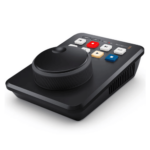
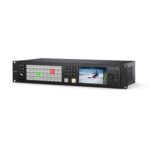
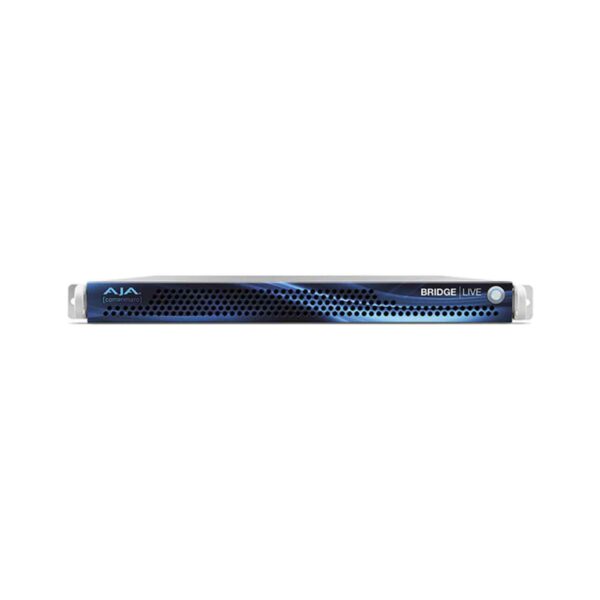
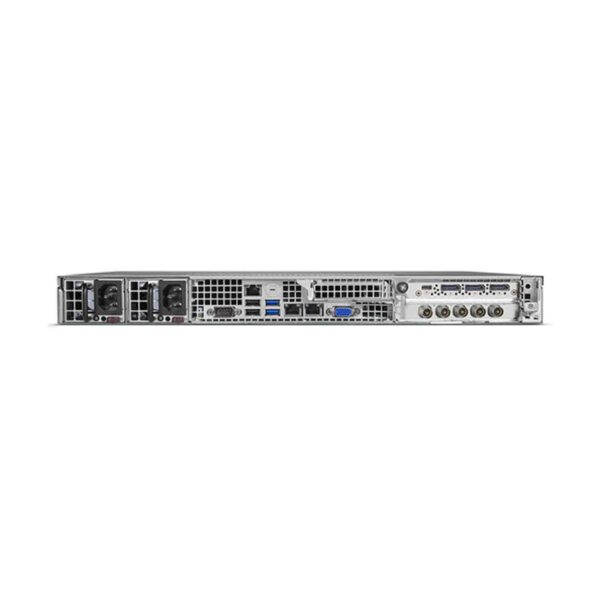

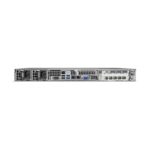



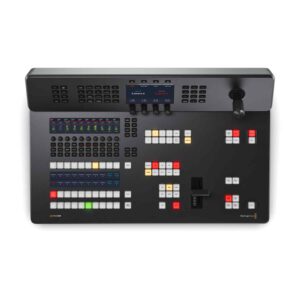







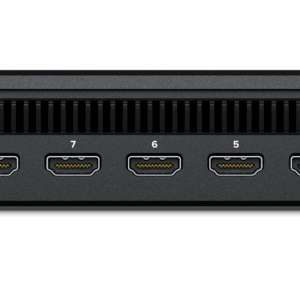


0.0 Average Rating Rated (0 Reviews)